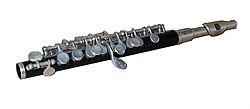| Description Links |
The Classical Piccolo Description Page |
| Buy cd's at Amazon Buy sheetmusic at SheetMusicPlus |
The piccolo (Italian for small) is a half-size flute, and a member of the woodwind family of musical instruments. The piccolo has the same fingerings as its larger sibling, the standard transverse flute, but the sound it produces is an octave higher than written. This gave rise to the name "ottavino," the name by which the instrument is referred to in the scores of Italian composers. Now only manufactured in C, piccolos were once made in D♭, as well. It was for that instrument that John Philip Sousa wrote his famous march, "Stars and Stripes Forever". In the orchestral setting, the piccolo player is often designated as Piccolo/Flute III or even Assistant Principal. The larger orchestras have designated this position as a Solo position due to the demands of the literature. Piccolos are often orchestrated to double (i.e. to play together with) the violins or the flutes, adding sparkle and brilliance to the overall sound because of the aforementioned one-octave transposition upwards. It is the highest-pitched instrument in an orchestra or band.[citation needed] Concertos have been composed for piccolo, including those by Lowell Liebermann, Sir Peter Maxwell Davies, Todd Goodman[1], Martin Amlin,[2] Will Gay Bottje,[3] Bruce Broughton, Valentino Bucchi, Avner Dorman,[4] Jean Doué, Michael Easton,[5] Egil Hovland, Guus Janssen, Tilo Medek, Dexter Morrill, Raymond Niverd, Daniel Pinkham, Thomas Schudel, and Allan Stephenson. Graham Waterhouse composed a quintet for piccolo and string quartet.
Traditional useHistorically, the piccolo had no keys, and should not be confused with the fife, or classical piccolo, which has a smaller bore and is therefore more strident. The piccolo is used in conjunction with marching drums in traditional formations at the Carnival of Basel, Switzerland. The piccolo was originally made of wood and was featured in many prominent composers' works. One of the earliest pieces to use the piccolo was Beethoven's Symphony No. 5 in C Minor, playing only during the final (IV) movement. Today, piccolos are made from a range of materials, from plastic (or resin), to silver, to wood. Finely made piccolos are often available with a variety of options similar to the flute, such as the split-E mechanism. Bibliography
References
External links
| |||||||||||||||||||||||||||||||||||
This article is licensed under the GNU Free Documentation License. It uses material from the Wikipedia article "Piccolo". Allthough most Wikipedia articles provide accurate information accuracy can not be guaranteed. | |||||||||||||||||||||||||||||||||||
Help us with donations or by making music available!
©2023 Classic Cat - the classical music directory

Bach, J.S.
Cello Suite No. 1 in G major
Marcin Masecki
Church Music
Adeste Fideles
Corale Polifonica Cascinese
Beethoven, L. van
Symphony No. 1 in C major
Vienna Philharmonic
Wagner, R.
Parsifal
Tomasz Konieczny
Joplin, S.
The entertainer
Tom Pascale
Webern, A.
Variations for Piano
Chiara Bertoglio



